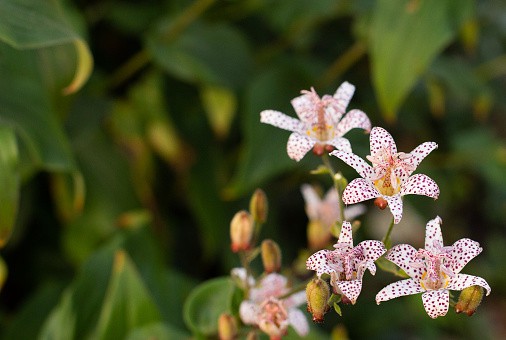The Japanese Toad Lily, Tricyrtis hirta, is a remarkable flowering plant with an unusual appearance. Native to East Asia, this flower has been cultivated in Japan for centuries, and is now widely available all over the world. The flowers look like orchids, with soft petals that surround the central throat of the bloom. Hundreds of delicate purple freckles decorate the petals and each flower has a yellow throat. This flower prefers to grow in damp, shady areas, and is a perfect choice for woodland gardens or shaded spots in a regular garden. Its genus name, Tricyrtis, is Latin for three lily, referring not only to its appearance, but to its place as the third genus in a series of similar bulbs from Japan and China. This flower belongs to the Liliaceae family.
How to Plant
Japanese Toad Lily is relatively easy to take care of and can thrive in many different environments. It prefers partial shade, and can handle full shade as well. The soil should be humus-rich and moisture-retentive, acidic to slightly alkaline. If you live in an area with colder winters, you can improve drainage by adding some gritty material, such as coarse sand or gravel. This will allow the roots to remain healthy during the cold months. When planting, make sure that you leave adequate spacing between plants to allow for adequate airflow and drying of the soil.
Water your plants occasionally, but do not over water. During the summer months, you can water your plants every few days up to once a week. During the colder months, reduce the frequency of watering. If you notice that your plant is starting to droop, increase the frequency of your watering. Japanese Toad Lily does not require much fertilizer, however, a weak liquid fertilizer or slow-release fertilizer every few months in the growing season can help to promote healthy growth.
Meaning and Symbolism
Japanese Toad Lily has a long history of associations with characters and symbols from Asia. The most common meaning associated with this flower is ‘determination.’ In China, it is said to bring luck and new opportunities. The flower is also used as a token of refined beauty in Japan. The unique color of the flower is thought to represent peace, purity, and hope. The flower is also used to signify strength, as its winding leaves and bold colors defy the passing of time.
History, Mythology, And Religious Significance
The Japanese Toad Lily has been a part of East Asian folklore and culture for centuries. It is often seen in traditional songs, poems and stories, and is a frequent choice for bridal bouquets in Japan. It was also often used to represent loyalty and friendship in traditional Chinese folktales. This flower is also significant in Buddhism, where it symbolizes wisdom, strength and compassion.
Flower Varieties and Their Defining Characteristics
The Japanese Toad Lily comes in several varieties, making it a great choice for both indoor and outdoor gardens. These varieties differ in size, flower color, and blooming time. The most common varieties are:
- Tricyrtis hirta ‘Miyazawae’ – The most common variety, it grows up to 2 feet tall and produces white to pale purple flowers with purple freckles.
- Tricyrtis hirta ‘Samurai’ – This variety has larger blooms with white petals surrounding a golden yellow throat.
- Tricyrtis hirta ‘Shogun’ – This variety is more compact and produces yellow-green flowers with purple speckles.
How to Pot and Repot
Since Japanese Toad Lily does not like to be disturbed, it is best to wait until the end of the season to repot them. To pot a Japanese Toad Lily, select a pot that is just a few inches larger than the bulb of the plant, and line the bottom of the pot with gravel. Use a soil mix that is specially formulated for bulbs, and place the plant carefully in the soil. Make sure to leave the top half of the bulb exposed. Firm the soil around the bulb and water thoroughly. Japanese Toad Lily does not like to be disturbed, so wait until the end of the season to repot.
How to Prune
Japanese Toad Lily produces healthy foliage throughout the growing season. At the end of the season, pruning is important to keep your plant looking its best. To prune your plant, use sharp, clean shears to snip off any dead or damaged foliage that has accumulated during the season. In addition, any stems that are starting to yellow or look sickly should be removed. Trim back the foliage, but be careful not to cut down to the bulb or rhizome of the plant.
How to Propagate
You can propagate Japanese Toad Lily by division or by seed. Division is the easiest, most effective way to propagate the plant. In late summer or early fall, divide the clumps of foliage and replant them in new pots. If you are growing your plant from seed, it may take several years before the plant blooms. Plant the seeds in late winter or early spring, so that they can germinate in the warm soil. Keep the soil moist and warm, and the plants should begin to sprout in a few weeks.
Common Pests and Diseases
Japanese Toad Lily is generally resistant to pests and diseases, however, some common problems such as powdery mildew, aphids, and stem and root rot can occur. If you notice any of these conditions, remove the affected foliage and treat the soil with an organic fungicide or insecticide. Make sure to keep the soil damp but not wet, and provide adequate airflow around the plants to prevent further problems.
Three Frequently Asked Questions About Tricyrtis Hirta
- Q: Is the Japanese Toad Lily an annual or perennial?
- A: The Japanese Toad Lily is a perennial flower that grows well in wooded or shaded locations.
- Q: Does the Japanese Toad Lily need a lot of sunlight?
- A: No, the Japanese Toad Lily prefers partial shade or even full shade.
- Q: Does the Japanese Toad Lily need to be fertilized?
- A: The Japanese Toad Lily only needs to be fertilized occasionally, but it will benefit from a weak liquid fertilizer or slow-release fertilizer every few months in the growing season.
Table Fact Sheet
| Name | Tricyrtis hirta |
|---|---|
| Family | Liliaceae |
| Plant Type | Shade-Loving Perennial |
| Mature Size | 1ft – 1.5ft |
| Sun Exposure | Partial Shade/Full Shade |
| Soil Type | Humus-Rich, Moisture-Retentive, Acidic to Alkaline |
| Soil pH | 5.5-7.5 |
| Bloom Time | Summer – Fall |
| Flower Color | White to Pale Purple with Purple Freckles, Yellow Throat |
| Hardiness Zones | 6 – 9 |
| Native Area | East Asia |
What we love from Amazon this week
Buy these wonderful flowers directly from Amazon:















